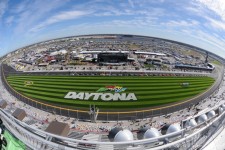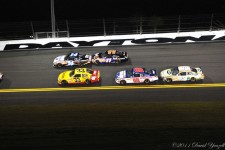At the restrictor plate tracks, the spotters are the hidden heroes play a crucial role of helping their drivers navigate through the pack. Spotters were heard barking on the radio throughout the entire race, helping their drivers find that perfect mate and keep them out of trouble. It was Regan Smith’s spotter who was blamed for the big wreck.
[media-credit name=”David Yeazell” align=”alignright” width=”225″] [/media-credit]So what exactly do the spotters do up on their perch?
[/media-credit]So what exactly do the spotters do up on their perch?
“My primary job is communicating to the driver what is going on around the racetrack; things he needs to be aware of both for safety as well as for competitive advantage,” Jon Bell, who spotted for Dakoda Armstrong last year in the ARCA Series, said. “On the track, the spotter tries to be constantly aware of anything that can affect our car. This can be anything from a crash around the corner to debris falling off another car to blinding sunshine in one corner. Since we do have the best seat in the house, we watch for situations developing with other cars—be it a “personality conflict” ala Brad and Carl that my driver needs to watch out for, or possibly a change in the racing “line” around the track that the driver and/or crew chief might want to adjust for.
“During caution laps we make sure the driver is aware of track safety workers and equipment that might pose a hazard. Remember, the cleanup and safety personnel don’t have a roll cage to protect them! Another important duty of the spotter is monitoring race control radio. Yep—we have to listen to two radios at the same time. We are the most direct means of communication from race control to both the driver and the crew chief and vice-versa. That’s how they control the “lucky dog” as well as line up prior to restarts.
“My work during pitting depends on what the crew chief wants. Bill Kimmel let me count the car into the pit stall as well as clear the driver out and away down pit road. Paul Andrews on the other hand wants only a quick pit road speed reminder, and “10 away!” warning. He counts down the car into the stall and clears it back out into traffic at which point I take over.
“Equally effective, but a very different style. So it’s not just a different driver that a spotter must adjust for.”
Rocky Ryan, spotter for David Ragan, explain that sometimes during pit stops, explanations are key on the radio.
“Some drivers even like to know where the two cars in front of them, coming on pit road are pitting,” Ryan said. “For example, the 24 and 48 are in front of us when the caution comes out. I will tell our driver where those two are pitting on pit road. That way, if say the 24’s pit stall is two stalls before us, and the 48’s pit stall is 10 stalls after us, then I will tell the driver that. This way, when the 24 turns left to go into his stall, then you aren’t surprised. Remember, it’s very difficult to see through these cars, so when someone turns left on pit road, is he trying to avoid something, or is he just going into his stall? Well, if he KNOWS that the 24 will be turning left before him, then he doesn’t worry. If the 48 turns before him, then he knows something has happened in front of us, and he better turn too.
“And if we have time, it’s always good for a spotter to look up and down pit road, during the stop, to get an idea of what the other teams are doing during their stops, i.e. two or four tires, just fuel, big adjustments, etc.”
For Bell, the hardest part of his job is actually the pre-race preparation.
“What time do I have to be up top? Did I get spare batteries? Radio? Snacks, drinks, coat, sunscreen?” Bell listed off. “Earlier this year at Salem, IN, I forgot to take my hat during practice and got roasted; except for the wonderful white stripe across the top of my head from the radio. That looked great the next week at work!”
Part of that preparation better include going to the bathroom.
“You better go before the race starts, because you are up there for 4 hours plus,” Ryan said. “You don’t go to the bathroom during a race. People can be killed because you’ve gone to the bathroom.”
Though Bell adds that travel isn’t the easiest thing, either.
“Travel is tough as well,” he said. “ARCA is very much a blue collar series. The majority of us don’t work in racing as a primary job. Living in Georgia adds a little to the commute since I’m not able to travel with the team, based in Mooresville NC.”
For Rocky Ryan, he says there are many difficult parts to the job.
“There isn’t one part that is more difficult than others,” Ryan said. “Understanding exactly what your role is can be difficult. You want to win every race, yet your primary functions is to be a safety factor. Do you do whatever it takes to win, or do you use your best judgment, and remember that your driver, and his family depend on YOU to bring him home safely?
“It’s difficult to stand on the roof for sometimes as long as 5 hours without a break, it’s difficult to see almost two miles across the track at a superspeedway. It’s difficult to carry enough equipment with you, to ensure that you have enough replacements, should something happen.
“It’s difficult to watch your car become involved in an accident, then to have to radio him to make sure he’s ok, then begin to describe the damage to the crew so that they can be ready to work on it when in gets back to the garage. But, the hardest part of the job should ALLWAYS be, that your drivers safety depends on YOU. Very bad things can, and have happened on the race track. The spotter is responsible for doing everything he/she can to protect their driver. Understanding that you can’t make a mistake, or people can be killed. That’s the hardest part of the job.”
For the spotters, they seem to always receive the criticism when a wreck happens in getting blamed for it or for not giving their driver the correct information to help them win.
“My attitude regarding that is pretty much the same as with anything I hear TV racing commentators say,” Bell said. “Until you have done what I do, who are you to critique my decisions and actions/reactions? If you are overly sensitive to other’s opinions of your calls, you won’t last long. Every person, whether fan, commentator, or competitor is entitled to their opinion, but unless you are my driver or crew chief—you’ll just get shrug from me.”
For Mike Calinoff, who spotters for Matt Kenseth, he says he values the criticism by who it comes from.
“It really depends who’s saying it,” Calinoff said. “If it’s coming from a driver then I think it’s usually valid. If it comes from a crew member who can only see the frontstrech or the media, I give the criticism less value.”
With a spotter, they also have to learn to spot on a different variety of different types of tracks, from road courses to short tracks to the restrictor plate tracks. In the course of spotting on a variety of tracks, it can cause a variety of likes and dislikes.
“Best track as far as the easiest for me is Martinsville, because it’s just a simple oval,” Chris Lambert, spotter for Brian Vickers, said. “The speeds are really low and it’s just a small, simple track.”
Rocky Ryan says the list varies depending on the spotter and what they like.
“Each spotter has their favorites and the ones that they prefer to miss,” Ryan said. “Personally, Bristol, Atlanta, Martinsville and Infineon are my favorites. And Phoenix, Indianapolis, Talladega and Watkins Glen are my least favorites. Sightlines, facilities and overall accommodations are a plus at the favorite tracks.
“As far as the least, Phoenix is the worst oval track to spot from, because they don’t put the spotters on the front stretch, we are located in turn one. We can see the entrance to pit road, we can’t see the bottom of turns three and four, and the cars are coming straight at you, so it is very difficult to clear them on the front stretch. Indy is tough, because it’s the only track we go to, that places the spotters inside the track and not outside of the track. So we are constantly turning to follow the race. Talladega is Talladega, you work so hard, harder than anywhere else, and can ruin a good day by someone else’s mistake. Watkins Glen is very tough because as a road course, we can not see all of the track. It’s takes 3 spotters per team to cover Watkins Glen, and if you put that many people on a radio, it is very difficult to relay information.”
If you’re looking to be a spotter, Bell says that you need to have empathy.
“I’d say empathy is a good start,” he said. “You really need to try to understand and feel what your driver is experiencing in that car. The spotter is the calming voice when circumstances aren’t great. You also may have to be a calming influence when things are going really great!”
Bell also says to get out there and get involved.
“Go to your local racetrack, get your behind down in the pits after the races, and meet the people down there,” he said. “I guarantee before long you will meet someone who would love to have your help—whatever help you can provide. Find what you’re good at and what you love and pursue it.
“Getting to the top of our sport is no easier, quicker, or less demanding than in football, baseball, or golf. Just as NASCAR Sprint Cup drivers are some of the best racing drivers in the world, their mechanics, pit crews, fabricators, and spotters are that good in their respective positions. I never pass up an opportunity to spot a race. Besides ARCA, this year I have worked for a team in the Pro Cup series, I have worked for Kimmel’s son and nephew, and when schedules permit I still love to follow my nephew to the track and spot for him. Every bit of practice I can get! Whenever the opportunity presents, I will unashamedly scan the Cup guys to learn their styles, timing, phrasings, anything I can try to adapt to improve my game. My goal is to rise as far in the sport as opportunity and ability allow me. God has given me a fantastic opportunity!”
Lambert says you also have to be a good multi-tasker.
“To be a good spotter you have to be able to multitask,” Lambert said. “You have to be 100% focused for about 3 1/2 — four hours a race and help your driver in every way that you can, give him any advantage that you can. During any given race I may wear many different hats. I’m a punching bag when he wants to vent, a cheerleader when he needs to be pumped up, a psychologist when he needs to be calmed down. We all go through several different emotions throughout a race and we have to be that calming voice no matter what is going on, we have to stay positive and keep everyone else’s heads up and digging.”



